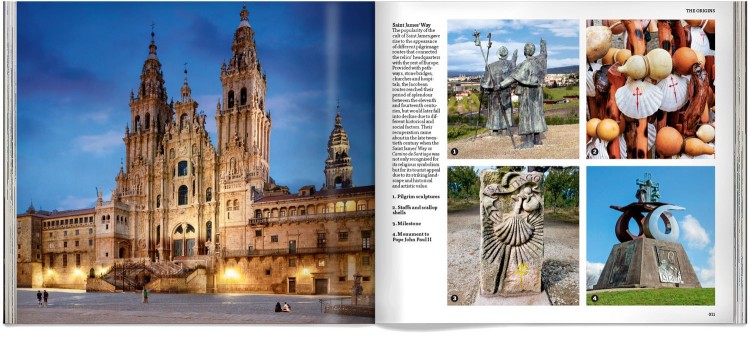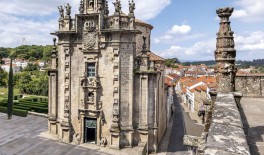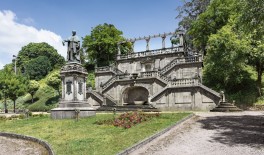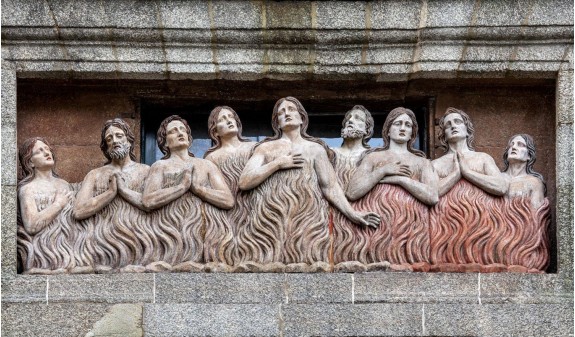Santiago de Compostela
A millennial cultural legacy
RETURN
About the book Santiago, a millennial cultural legacy
This book on Santiago de Compostela carries out a comprehensive photographic tour of its architecture, monuments and the most important places in the city. Its pages provide fascinating information about the history and most important cultural heritage of this major pilgrimage destination.
The more than 200 photographs of Santiago de Compostela in this book published by Dosde provide a detailed look at the artistic and architectural heritage of a city, whose millennial history began to be forged after discovering St. James the Apostle's tomb.
The book, published by Dosde, is divided into chapters that explore the different areas of the city and its most important monuments: Santiago Cathedral, the Old Town, the Monastery of San Martín Pinario, Fonseca College, the City Walls, the Ciudad de la Cultura… The reader will be provided with an overall view of Santiago de Compostela as well as a fascinating detailed tour of the city, thanks to this book belonging to our books of Santiago de Compostela.
The more than 200 photographs of Santiago de Compostela in this book published by Dosde provide a detailed look at the artistic and architectural heritage of a city, whose millennial history began to be forged after discovering St. James the Apostle's tomb.
The book, published by Dosde, is divided into chapters that explore the different areas of the city and its most important monuments: Santiago Cathedral, the Old Town, the Monastery of San Martín Pinario, Fonseca College, the City Walls, the Ciudad de la Cultura… The reader will be provided with an overall view of Santiago de Compostela as well as a fascinating detailed tour of the city, thanks to this book belonging to our books of Santiago de Compostela.
Photo Edition
Santiago de Compostela
Official product
-
 Made with environmentally friendly paper
Made with environmentally friendly paper -
 Multilanguage: available in 5 languages
Multilanguage: available in 5 languages -
 More than 200 top quality photographs
More than 200 top quality photographs
About the book Santiago, a millennial cultural legacy
This book on Santiago de Compostela carries out a comprehensive photographic tour of its architecture, monuments and the most important places in the city. Its pages provide fascinating information about the history and most important cultural heritage of this major pilgrimage destination.
The more than 200 photographs of Santiago de Compostela in this book published by Dosde provide a detailed look at the artistic and architectural heritage of a city, whose millennial history began to be forged after discovering St. James the Apostle's tomb.
The book, published by Dosde, is divided into chapters that explore the different areas of the city and its most important monuments: Santiago Cathedral, the Old Town, the Monastery of San Martín Pinario, Fonseca College, the City Walls, the Ciudad de la Cultura… The reader will be provided with an overall view of Santiago de Compostela as well as a fascinating detailed tour of the city, thanks to this book belonging to our books of Santiago de Compostela.
The more than 200 photographs of Santiago de Compostela in this book published by Dosde provide a detailed look at the artistic and architectural heritage of a city, whose millennial history began to be forged after discovering St. James the Apostle's tomb.
The book, published by Dosde, is divided into chapters that explore the different areas of the city and its most important monuments: Santiago Cathedral, the Old Town, the Monastery of San Martín Pinario, Fonseca College, the City Walls, the Ciudad de la Cultura… The reader will be provided with an overall view of Santiago de Compostela as well as a fascinating detailed tour of the city, thanks to this book belonging to our books of Santiago de Compostela.
No reviews yet.
Additional Information
- Additional Information
- Subtitle: A millennial cultural legacy
- Weight (g): 415
- Binding: Paperback with flaps
- Size (cm): 19,5 x 17,5
- Author: Dosde
- Pages: 0
- Edition: Photo Edition
What to see in Santiago de Compostela?
Santiago de Compostela’s foundation dates back to the discovery of the tomb of St. James the Greater or Santiago in Spanish, one of Jesus Christ’s closest disciples. A temple was erected to hold the sacred relics of James the Apostle, around which a city gradually formed. As the number of worshippers grew, the sanctuary was replaced by a large cathedral, which would be modified over time and convert into a monument bursting with centuries of history.
The popularity of the cult of Saint James led to the appearance of different pilgrimage routes that connected the holy relics with the rest of Europe and reached its period of splendour between the eleventh and fourteenth centuries. From the sixteenth century, the University, one of the oldest in Spain, made a decisive contribution to the city's expansion.
Santiago de Compostela's development was largely due to its relevance as a pilgrimage site. Its historical centre is now considered as one of the most important historical-artistic sites in Europe, and in 1985 was declared a World Heritage Site by Unesco.
The Obradoiro Square is deemed the spiritual heart of the city, the meeting place for pilgrims and visitors, in whose centre is a granite plaque that indicates the “kilometre zero” of Saint James’ Way. In this square are emblematic buildings such as the Raxoi Palace, the Hostal dos Reis Católicos and the Gelmírez Palace.
Rúa do Vilar is the most important street in the historical centre and boasts numerous stately homes belonging to Santiago’s former aristocrats. Then there are Rúa de Franco, Rúa Preguntoiro and Rúa Nova, which were the first residential roads to emerge in the medieval city. Within this area are several university buildings, such as the Faculty of Geography and History and Fonseca College, holding the General Library of the University of Santiago de Compostela.
Another place of interest in Santiago de Compostela is the Provisions Market. Its original building was inaugurated in 1870 and it remained in business until 1925, the year it was demolished, due to ongoing structural problems. The present Mercado de Abastos was built between 1937 and 1941, with aesthetic features reminiscent of medieval architecture, in tune with the monumental character of the Galician city.
At this time, the Alameda Park was created, an important leisure area for Santiago’s inhabitants, which nowadays acts as a green belt between the historical centre and the South Campus of the University. It boasts Modernist constructions such as the Leisure Pavillion designed by Antonio Palacios, as well as numerous sculptures and monuments of key figures in Galician culture.
The city wall area has numerous buildings that played an important role in Santiago's history, like the Santa Clara Convent, the Collegiate Church of Sar, the convent of Santo Domingo de Bonaval and the Belvís Seminary, originally used for the schooling of the priests.
Currently, apart from those four buildings, there are other emblematic buildings such as the Hejduk Towers, designed by North American architect John Hejduk. Likewise, in 2020 the inauguration of the Edificio Fontán is planned, which will host university services.
The popularity of the cult of Saint James led to the appearance of different pilgrimage routes that connected the holy relics with the rest of Europe and reached its period of splendour between the eleventh and fourteenth centuries. From the sixteenth century, the University, one of the oldest in Spain, made a decisive contribution to the city's expansion.
Santiago de Compostela's development was largely due to its relevance as a pilgrimage site. Its historical centre is now considered as one of the most important historical-artistic sites in Europe, and in 1985 was declared a World Heritage Site by Unesco.
The historical centre
The presence of the temple erected over the apostle’s tomb led to the urban layout that today constitutes the historical centre of Santiago de Compostela. In this area, churches and convents connected to Jacobean worship coexist with hospitals used to assist pilgrims, alongside university buildings, stately homes and ecclesiastical palaces.The Obradoiro Square is deemed the spiritual heart of the city, the meeting place for pilgrims and visitors, in whose centre is a granite plaque that indicates the “kilometre zero” of Saint James’ Way. In this square are emblematic buildings such as the Raxoi Palace, the Hostal dos Reis Católicos and the Gelmírez Palace.
Rúa do Vilar is the most important street in the historical centre and boasts numerous stately homes belonging to Santiago’s former aristocrats. Then there are Rúa de Franco, Rúa Preguntoiro and Rúa Nova, which were the first residential roads to emerge in the medieval city. Within this area are several university buildings, such as the Faculty of Geography and History and Fonseca College, holding the General Library of the University of Santiago de Compostela.
Another place of interest in Santiago de Compostela is the Provisions Market. Its original building was inaugurated in 1870 and it remained in business until 1925, the year it was demolished, due to ongoing structural problems. The present Mercado de Abastos was built between 1937 and 1941, with aesthetic features reminiscent of medieval architecture, in tune with the monumental character of the Galician city.
Beyond the city walls
The development of Jacobean culture led to the city's growth and in the late nineteenth century, the demolition of the medieval walls resulted in the city’s annexation of the towns and rural areas near to the historical centre.At this time, the Alameda Park was created, an important leisure area for Santiago’s inhabitants, which nowadays acts as a green belt between the historical centre and the South Campus of the University. It boasts Modernist constructions such as the Leisure Pavillion designed by Antonio Palacios, as well as numerous sculptures and monuments of key figures in Galician culture.
The city wall area has numerous buildings that played an important role in Santiago's history, like the Santa Clara Convent, the Collegiate Church of Sar, the convent of Santo Domingo de Bonaval and the Belvís Seminary, originally used for the schooling of the priests.
The City of Culture
In the late twentieth century, both the revival of Jacobean pilgrimages and the growing popularity of Santiago de Compostela as a tourist destination highlighted the necessity to provide the city with better cultural infrastructures. Thus, the project of the Ciudad de la Cultura on Monte Gaiás came into being, carried out by Peter Eisenman. The North-American architect designed different spaces which include the Library, the Newspaper Library, the Galician History Museum and Central Services.Currently, apart from those four buildings, there are other emblematic buildings such as the Hejduk Towers, designed by North American architect John Hejduk. Likewise, in 2020 the inauguration of the Edificio Fontán is planned, which will host university services.



















